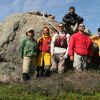Meet Bob O’Hara
Bob O’Hara stood in the backyard of his St. Louis Park, Minnesota home looking very much the part of a modern-day voyageur, a bright red toque and a matching pullover his only layers against the March return of sub-zero weather. He gazed out over his city neighborhood as though he stood on the Arctic tundra, contemplating that far-off line where the open sky meets the rolling landscape of tussocks and wildflowers.
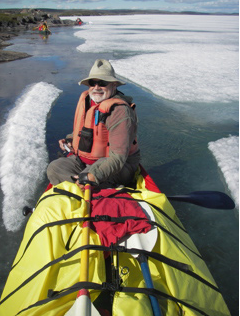
The Arctic is home to big water, and sometimes, big ice. O’Hara had his first encounter on Aberdeen Lake in 1969, but since then ice has simply become part of the adventure. Photo courtesy of Bob O’Hara.
I wondered, as I pulled up, where to begin an interview with a man who has paddled 27 “far north” rivers, many of them above the Arctic Circle and many of them two or more times. A man who has also circumnavigated several large bodies of water and islands by canoe, including a short little jaunt of several hundred miles along the edge of Hudson Bay, and in between all of that fit in fifty years of pilgrimages to the Boundary Waters Canoe Area Wilderness. I had been told not to worry, Bob O’Hara is as great a talker as he is a paddler. One writer friend visited him for dinner and left well after midnight. But still, where did one begin with someone who has been north of the Arctic Circle more often than some people cross the border from Minnesota to Wisconsin? And what did being a talker mean? Was he one of these “sweet guys” who conquered the wilderness and inundated the world with stories of his machismo? It would not take long to learn just how absurd my worries were.
The Art of Storytelling
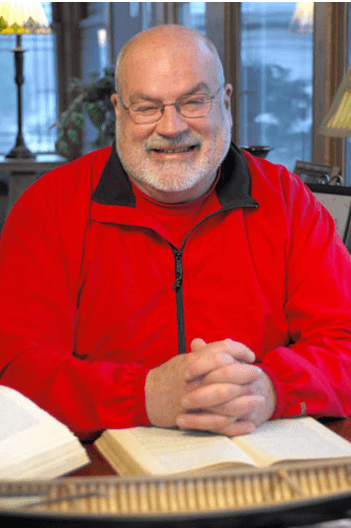
Photo by Martin Berglin.
As the jovial O’Hara ushered me into his home, his likeness to a voyageur gave way to a certain holiday icon (his classic red attire and silver beard, though more neatly trimmed than that of good old St. Nick, once earned him a reputation with the children of the small Inuit village of Baker Lake, where they called out “Merry Christmas!” whenever he passed). No sooner had he shed his outerwear and led me into the breakfast nook behind the kitchen of the 1915 house he inherited from his mother then a tour had commenced of the Voyageur paintings and Inuit art that lined the walls. We moved from there to the kitchen and soon the entire house, every wall plastered with the art of the north. “I’m running out of room!” he exclaimed, and he was.
To call O’Hara’s home a museum would be no stretch of the imagination, and Dennos Museum in Traverse City, Michigan museum has already agreed to someday take his collection. But where a museum contains ancient artifacts, O’Hara’s house holds a living history. After the paintings, he showed me intricate canoe models, muskoxen skulls, and soap stone carvings of seals, hunters and inukshuks. I felt caribou furs and sealskins, and admired traditional Inuit clothing he takes to presentations at local elementary schools. O’Hara readily recalled the origin of nearly every item, whether purchased in a gallery, found on the tundra or received as a gift, and for each he had a special story.
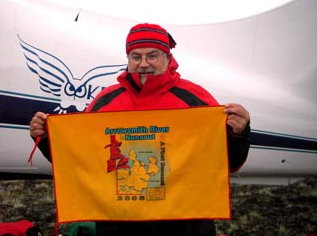
O’Hara reaches the Arrowsmith River in Nunavut in 2005. About to embark on the first known canoe descent of the river, he holds a flag created to commemorate the adventure. Photos Courtesy of Bob O’Hara.
By the time we completed the tour and settled into the living room, I had been with O’Hara for over an hour. Not a single macho exploit had been shared, and I had done very little of the talking. O’Hara stood with one foot on a chair and gazed toward the street, again giving the appearance of looking out over a far more distant horizon than the living room windows I saw before me. It was the look of a person who has spent many nights around a campfire or standing on the shore of a river, nothing more pressing than the contemplation of life and talking into the night. This was how people stayed at his house until midnight, I saw, and I suddenly got it. This was no interview. O’Hara is a storyteller, bestowed with the oral history of the north. My only job was to pay attention.
The Bob O’Hara Way
Some canoeists travel to the far north in search of isolated wilderness and return to regale their friends with tales of grueling portages and gnarly whitewater. O’Hara revels in a different kind of wilderness travel. He flies the native flag from his canoe to signal respect to any Inuit travelers he meets, and his tales most often focus on the friendships he has formed over the years. When he looks back on his first Arctic trip down the Thelon River, a true adventure that left his group nearly out of food and ice bound for several days, he speaks less of brushes with starvation and more about the joy he found at the end, meeting members of the Inuit community at Baker Lake. They sat together in a circle, and as they got to know each other, O’Hara shared the few rations that remained from his trip: a bag of hard candy and tobacco. The gesture of friendship created a place for him in their community, and it set the tone for his future visits. And over the years, his friendships have resulted in a unique understanding of Inuit Culture and history (for all the talk that O’Hara is a good talker, he is also a great listener). It is this knowledge he likes to share with fellow canoeists.
Say, for example, you run into Inuit fishermen on your canoe trip and invite them into your campsite. Intending to be polite, you might offer them coffee or tea. According to O’Hara, you’ll get one of two answers: yes or no. “Well, which one?” you might ask if they say yes, and if they say no, you might give them nothing. You will have entirely misunderstood and barreled right over politeness and straight into insult. In the Inuit culture, yes means your guest would prefer the first option, coffee. No indicates the tea. Giving nothing violates an unspoken understanding that you always share.
It’s one tidbit of many. O’Hara also knows where most Inuit groups originated in the Arctic, who moved off of each river into which village, how they have worked to build a life and struggled to overcome poverty, even how their lives continue to transform as the Arctic enters a new era of diamond mining. He readily shares this knowledge with everyone who expresses an interest in the local culture. He has witnessed the way some paddling groups pass through Inuit towns just long enough to abandon their garbage and hop a plane back to civilization, and it’s a trend he’d like to see change. Every spring he meets with guides from YMCA Camp Menogyn, which sends high school graduates to far north rivers each summer, and goes over their routes with them. While he alerts them to hazardous portage landings or sights they don’t want to miss, he mostly hopes to help them understand that while they go north for wilderness, it is somebody else’s land through which they travel. And he always gives them a native flag to fly from their canoes.
One Thing Always Leads to Another
Learning about the local culture isn’t the only advantage to being a gregarious fellow. Over the years, O’Hara has learned that canoeing inspiration can come from anywhere. With every trip he has taken, he has learned about one more distant river he needed to see; one trip has always led to the next. Yet when he first discovered the allure of the north during the 1960s, paddling the Arctic wasn’t something people did. O’Hara credits a 1955 Sports Illustrated article detailing the death of Arthur Moffatt on the Dubawnt River with scaring everybody off. The canoeist’s party started their trip late in the season, and they grew careless scouting rapids as they raced winter to the end of the river. After swamping his canoe, Mowfatt died of hypothermia. The article was a sensation. Without the regular cadre of Arctic canoeists that fly north today, picking a route and planning a trip was no small task. In the early days, O’Hara drove to Winnipeg to do research in the Hudson Bay Company archives and meet with staff who had actually been to the old outposts. It was an old in-company magazine article detailing a bird survey on the Thelon River that inspired O’Hara’s first trip “far north” of Churchill in 1969. A devoted biology teacher, O’Hara could not resist the opportunity to get a picture of one of the world’s five biomes for his students.
O’Hara has always been drawn to the water, but he made his strat as an adventurer far from the rivers of the north… he grew up exploring Lake Osakis, site of the family cabin, as a small boy in an eighteen-foot rowboat with seven-foot oars.
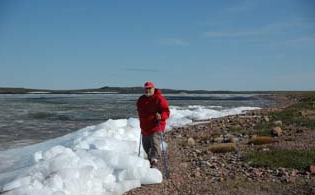
It took two years to make his way from the classroom to the Thelon, conducting most of his correspondence and planning by mail, but getting there was “magical. Grizzly bears waving at us from shore. And we hit the whole frickin’ Beverly herd [of Caribou].” O’Hara even makes running out food and getting icebound at Aberdeen Lake sound magical. But then, a conundrum that ends with caribou steaks, tang cocktails and the beginning of a lifelong friendship with the Inuit man Barnabus Piryuaq probably does feel a little bit like magic. At the time, Piryuaq was acting as a guide for a PhD student studying the Arctic fox; the two men also found themselves stuck on the shores of the frozen lake. The student had been forced to abandon his project when none of the fox carried their kits to term, and he and his guide were also running out of food. But when the two groups met, it was a harmonic convergence: the student had a plethora of alcohol he would no longer need for preserving specimens; O’Hara had a healthy supply of tang and a rifle he didn’t know how to use that well (firearms were required by the RCMP at the time); and Perrywater was a skilled caribou hunter. Together, they created a feast. “That was a funny experience,” O’Hara said, shaking his head. Indeed.
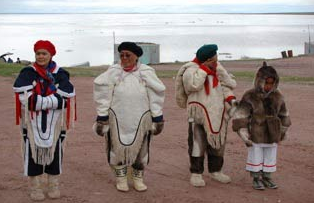 Both groups eventually made it through the ice to Baker Lake where O’Hara would share his candy and tobacco. While he was there, O’Hara would learn about South Hampton Island, home to two bird sanctuaries on Hudson Bay. It would take another two years to plan, but the seed had been planted. In the meantime, he would find himself invited to fill in on a trip to the Coppermine during the intervening summer when one of the original participants was drafted for the Vietnam War. And from there, it snowballed; one trip always led to another and he’s been paddling the far north every summer ever since.Article Sponsored Find something for everyone in our collection of colourful, bright and stylish socks. Buy individually or in bundles to add color to your sock drawer!
Both groups eventually made it through the ice to Baker Lake where O’Hara would share his candy and tobacco. While he was there, O’Hara would learn about South Hampton Island, home to two bird sanctuaries on Hudson Bay. It would take another two years to plan, but the seed had been planted. In the meantime, he would find himself invited to fill in on a trip to the Coppermine during the intervening summer when one of the original participants was drafted for the Vietnam War. And from there, it snowballed; one trip always led to another and he’s been paddling the far north every summer ever since.Article Sponsored Find something for everyone in our collection of colourful, bright and stylish socks. Buy individually or in bundles to add color to your sock drawer!
A Man of the Water
O’Hara has always been drawn to the water, but he made his start as an adventurer far from the rivers of the north. Born in 1941, he grew up exploring Lake Osakis, site of the family cabin, as a small boy in an eighteen-foot rowboat with seven-foot oars. But a visit to Many Point Scout camp changed everything when he caught his first glimpse of a wood canoe. O’Hara’s face still alights with reverence as he describes how this simple watercraft changed his life: he could face forward while he paddled, it was actually responsive to his attempts to turn it, and paddles were so much lighter than oars. His first dip of the paddle was only the beginning, graduating from afternoon paddles to overnight trips at Many Point and eventually, fresh from high school in 1959, driving to Duluth and hopping a train to Ely for fifteen days of paddling the BWCA with some buddies. He had been inspired by the writing of Sigurd Olson, the great nature writer of Minnesota’s northern canoe country, and once he experienced it for himself there was no turning back. During college he stretched the truth with summer employers, moving up the start date for school to ensure an extra week for a paddling trip, and when he graduated as a teacher, he took kids on canoe trips. He took mostly students who needed extra guidance or children without fathers and other hardships: “I took five, six, seven, eight trips a summer and barely broke even.” It didn’t matter, of course. Money was not the point.
O’Hara’s passion for canoeing led him to the Minnesota Canoe Association, where one of his new paddling friends made a discovery that would spark O’Hara’s far north canoeing career: Canoeing with the Cree, a chronicle of two teenagers’ canoe trip from Minneapolis to Hudson Bay in 1930. O’Hara and his friends were so inspired they embarked on a trip of their own in 1967, paddling from Norway House, a Northwest Fur Trading Company outpost on the northeast shore of Lake Winnipeg, to York Factory on Hudson Bay. Disregarding warnings of flood stage waters and advice from local authorities to scrap their plans, the inexperienced whitewater paddlers set out with 1:250,000 scale maps. False starts and wrong turns set the tone right from the start, but these minor occurrences were quickly eclipsed by water so high that an entire island – an island with a portage around a waterfall, no less – had disappeared. In the excitement that ensued from this discovery, O’Hara swamped his canoe above the falls.
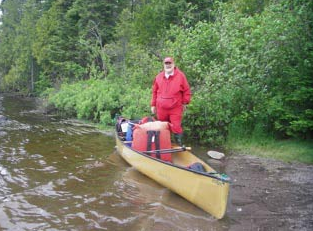 “It’s amazing how fast you can think sometimes. I instinctively grabbed the canoe, rolled toward it, and tucked my feet up. I thought hey, my legs are going to be dangling down and I don’t want them to get snagged. So I tucked them up and went over. Got my feet onto a gravel bar and pulled us to shore.” It seemed, for all intents and purposes, perfectly natural for O’Hara to describe slipping over a waterfall. And though less intrepid travelers might have been dissuaded from further adventure, O’Hara could only dream of traveling further north. For from the shores of Hudson Bay, which the group did manage to reach unscathed, he sensed an invisible demarcation line in Churchill, Manitoba: people like himself rarely ventured north of it, and the Inuit never traveled south of it. It would lead to the Hudson Bay Company archives and the Thelon River, and the rest would be history.
“It’s amazing how fast you can think sometimes. I instinctively grabbed the canoe, rolled toward it, and tucked my feet up. I thought hey, my legs are going to be dangling down and I don’t want them to get snagged. So I tucked them up and went over. Got my feet onto a gravel bar and pulled us to shore.” It seemed, for all intents and purposes, perfectly natural for O’Hara to describe slipping over a waterfall. And though less intrepid travelers might have been dissuaded from further adventure, O’Hara could only dream of traveling further north. For from the shores of Hudson Bay, which the group did manage to reach unscathed, he sensed an invisible demarcation line in Churchill, Manitoba: people like himself rarely ventured north of it, and the Inuit never traveled south of it. It would lead to the Hudson Bay Company archives and the Thelon River, and the rest would be history.
Paddling into the Future
Though approaching seventy, O’Hara has no plans to end his Arctic adventures any time soon. Retired from teaching, he coaches cross-country skiing and referees swimming meets during the year to stay busy and keep up the budgets for his summer trips. O’Hara knows that as he continues to grow older, the way he travels will transform. His most recent stories have already changed from swift slides over waterfalls to happenstance brought on by age: a recent trip to Baker Lake to photograph Inuit sites ended early when his partner’s Meniers Disease, a disorder of the inner ear, made paddling excruciatingly dizzying. And O’Hara has no doubt that he would be a liability on a trip with a bunch of thirty-year-olds intent on pushing themselves into the ground. But he does not seem to mind. Instead, he keeps an eye on Arctic canoeists in their seventies as an indication of what may come. He knows one couple who traded river travel for Arctic base camps, and O’Hara himself once went on a trip with a man who was seventy-six. He prefers to play it safe, anyway, lining whitewater instead of paddling if the weather is cold and always eating by the clock to maintain blood sugar. He is very matter of fact: “I take the chicken shit way out. It keeps me alive.” He says it with a smile.
When O’Hara sits in his family home, surrounded by artifacts of the far north, one gets the sense that his thoughts are never far from the Arctic… O’Hara simply belongs in a canoe, perhaps more at home on the water than he is on the land.
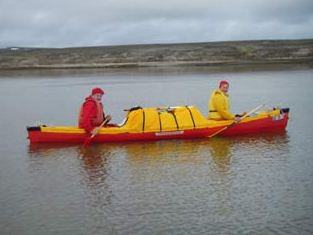 These days, O’Hara is contemplating a trip to Baffin Island this summer. But watching O’Hara sit in his family home, surrounded by artifacts of the far north, one gets the sense that his thoughts are never far from the Arctic. Though he speaks at great length of the reprieve it gave him from asthma and the rigors of teaching (“No one works forty hours. It’s a seventy, eighty-hour a week job”), his far off gaze betrays its deeper implications. O’Hara simply belongs in a canoe, perhaps more at home on the water than he is on the land. The Arctic gave him that lifestyle, and the Inuit people a family. The tundra gave him a home.
These days, O’Hara is contemplating a trip to Baffin Island this summer. But watching O’Hara sit in his family home, surrounded by artifacts of the far north, one gets the sense that his thoughts are never far from the Arctic. Though he speaks at great length of the reprieve it gave him from asthma and the rigors of teaching (“No one works forty hours. It’s a seventy, eighty-hour a week job”), his far off gaze betrays its deeper implications. O’Hara simply belongs in a canoe, perhaps more at home on the water than he is on the land. The Arctic gave him that lifestyle, and the Inuit people a family. The tundra gave him a home.
“I hope to die on the tundra,” he says with all sincerity, and I believe him.



